Abstract
1. A method of classification of muscle spindle afferents using succinylcholine (SCh) and ramp stretches has recently been described, which appears to estimate separately the strength of influence of bag1 (b1) and of bag2 (b2) intrafusal fibres. Increase in dynamic difference (delta DD) indicates b1 influence whilst increase in initial frequency (delta IF) indicates b2 influence. The significance of this classification has now been examined by correlation with the strength of synaptic projection of jaw muscle spindle afferents to the fifth motor nucleus (MotV) and the supratrigeminal region (STR) in anaesthetized cats. 2. Projection strength was estimated by computing the extracellular focal synaptic potential (FSP) from spike-triggered averages of 1024 sweeps at 100 microns intervals along tracks through STR and MotV. Trigger pulses were derived from spindle afferent cell bodies of the jaw-closer muscles recorded in the mesencephalic trigeminal nucleus, and characterized by the effect of SCh on their responses to ramp-and-hold stretches. 3. The maximum size of FSPs in tracks traversing STR and MotV ranged from 2.08 to 36.99 microV with a mean of 7.55 microV. The amplitudes were bimodally distributed into roughly equal-sized groups with high and low amplitude FSPs. 4. Mean values of delta IF were significantly greater for the group with large FSPs than for those with small FSPs. There were no significant differences in delta DD. FSP amplitude was significantly positively correlated with delta IF, but not with delta DD. 5. Spindle afferents with high values of FSP amplitude in MotV had a wide range of values of delta DD (b1b2c and b2c groups), while units with large FSPs in STR were all in the b2c category. Some evidence is presented to indicate that this reflects a preferential projection of secondary afferents to the STR. 6. For those units with projection to both STR and to MotV, there was a significant positive correlation between FSP amplitude in the two nuclei. 7. These results indicate that the extent of the b2 influence on spindle afferents predicts the central projection strength better than does the b1 influence. This finding is discussed from the viewpoint of possible developmental and functional issues.
Full text
PDF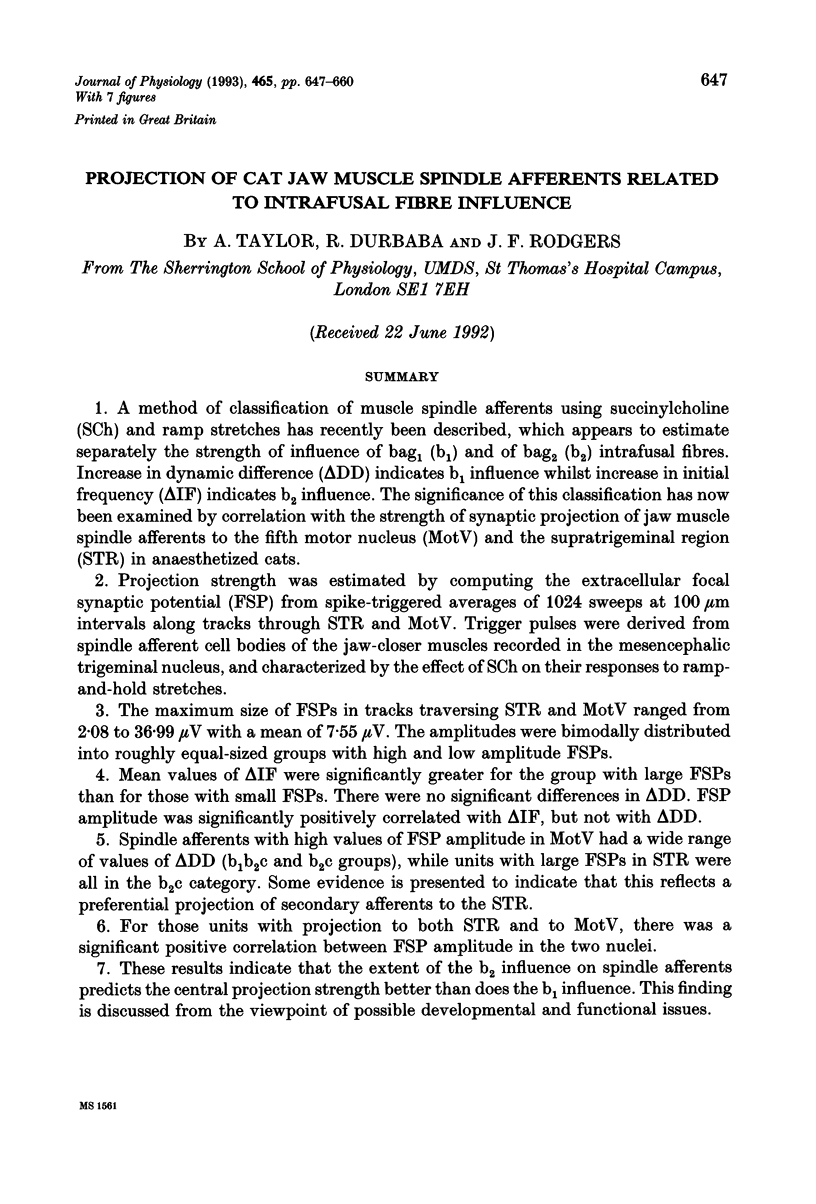
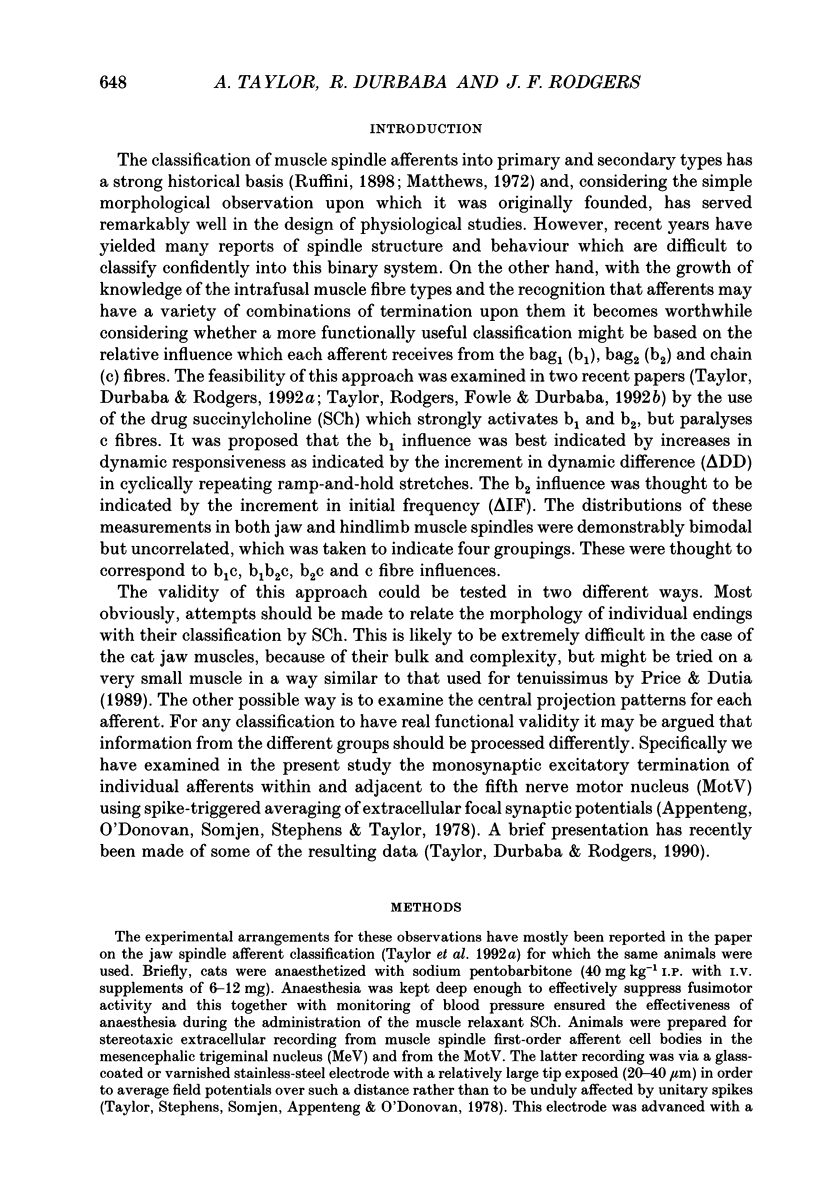
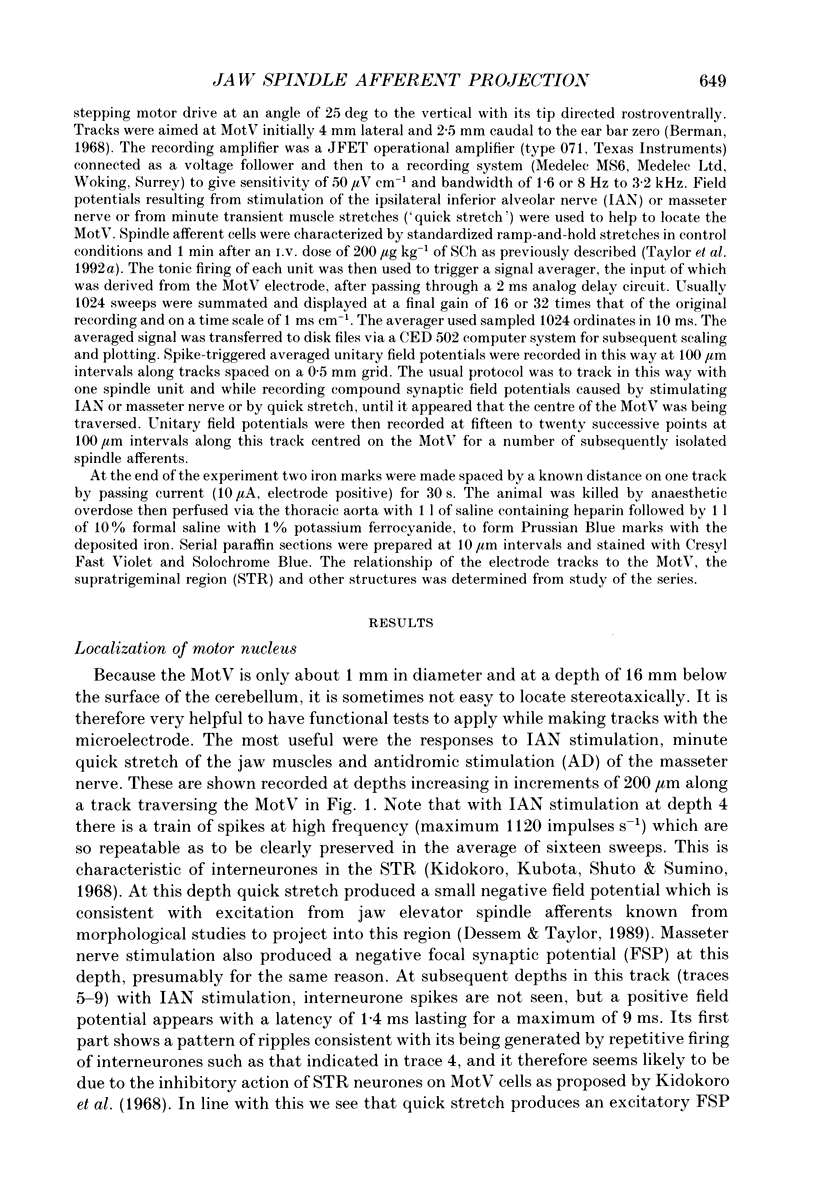
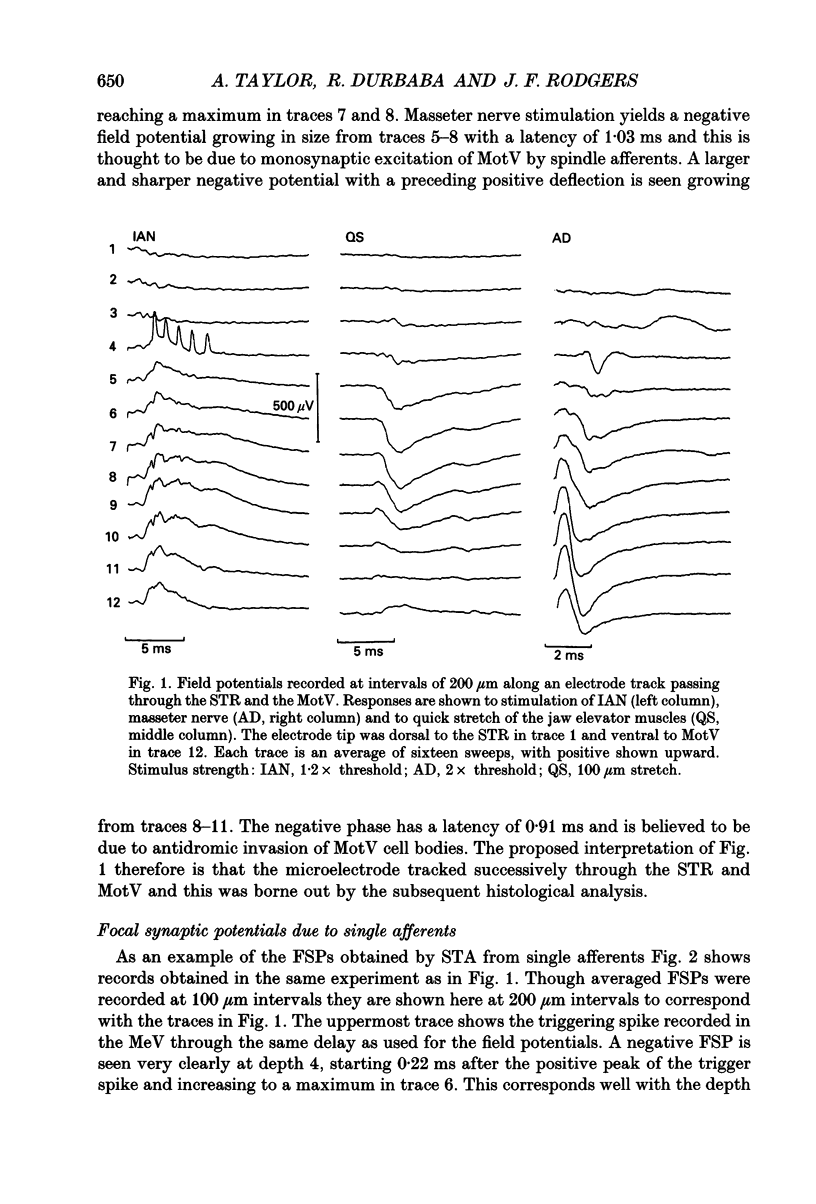
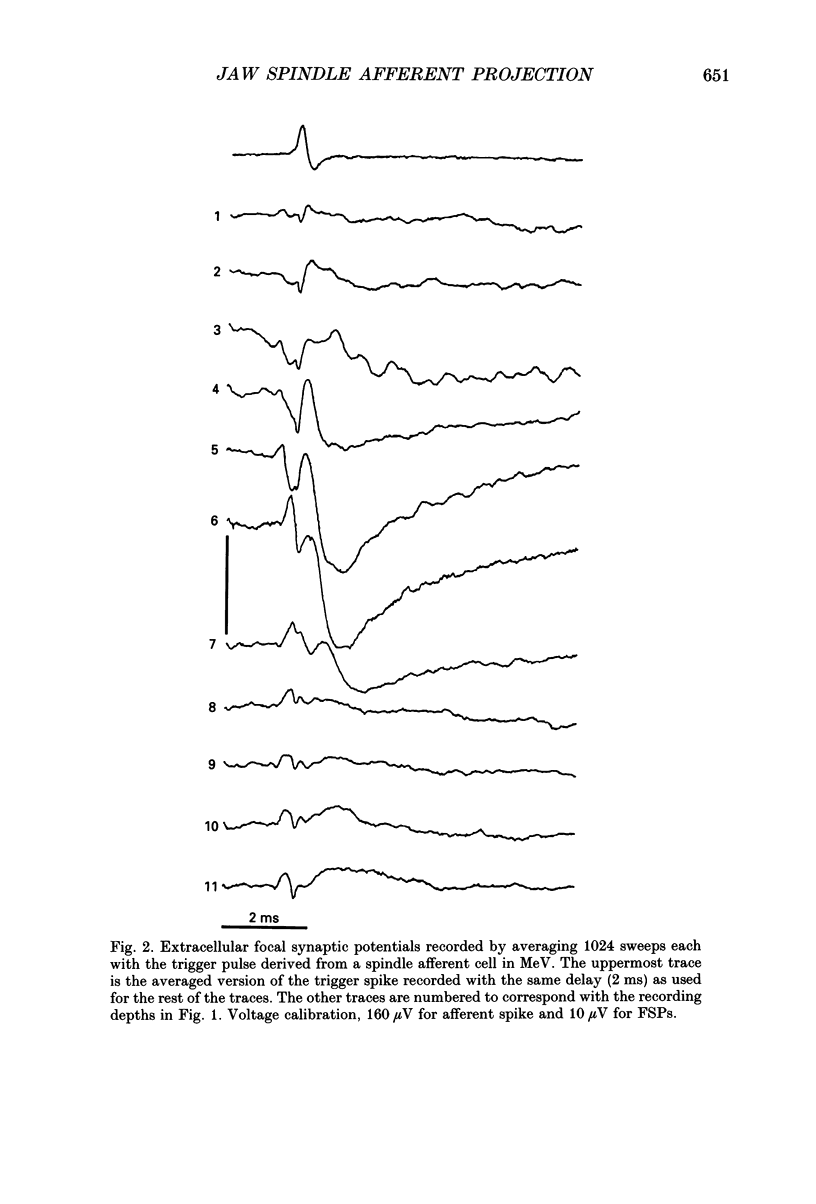
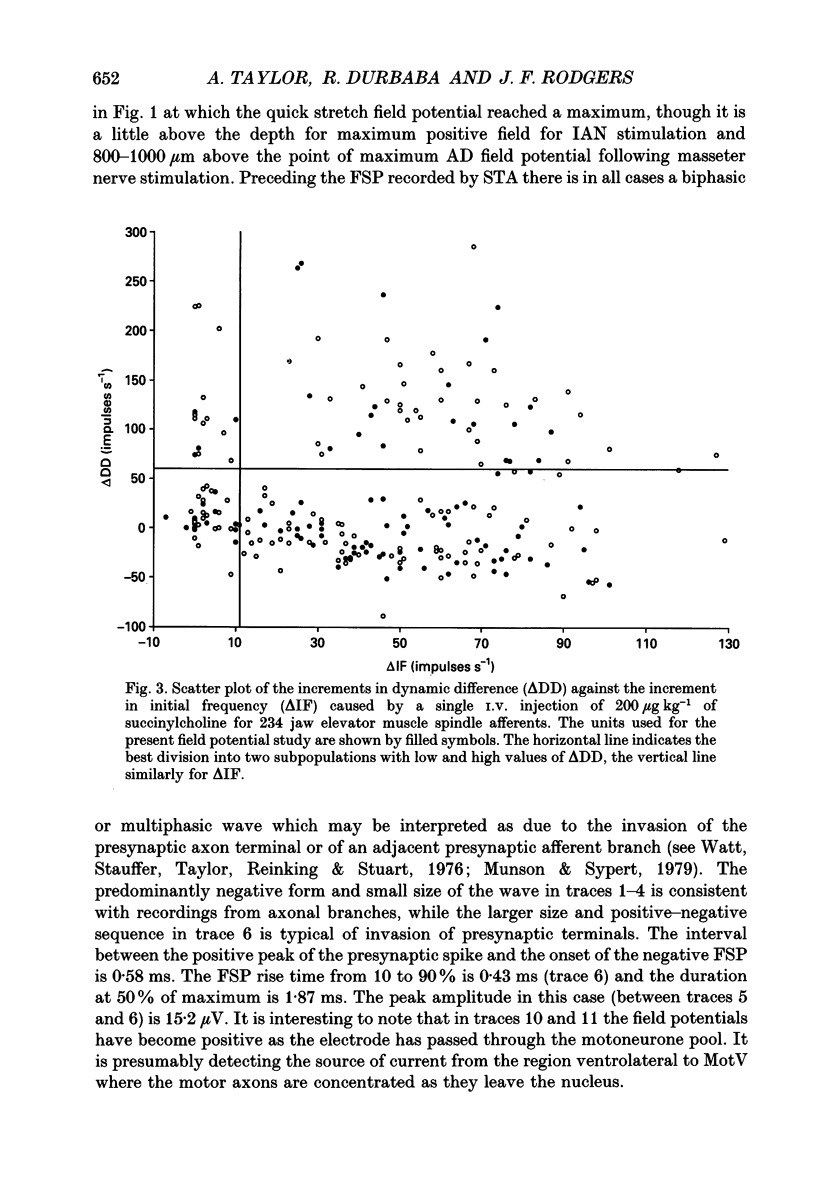
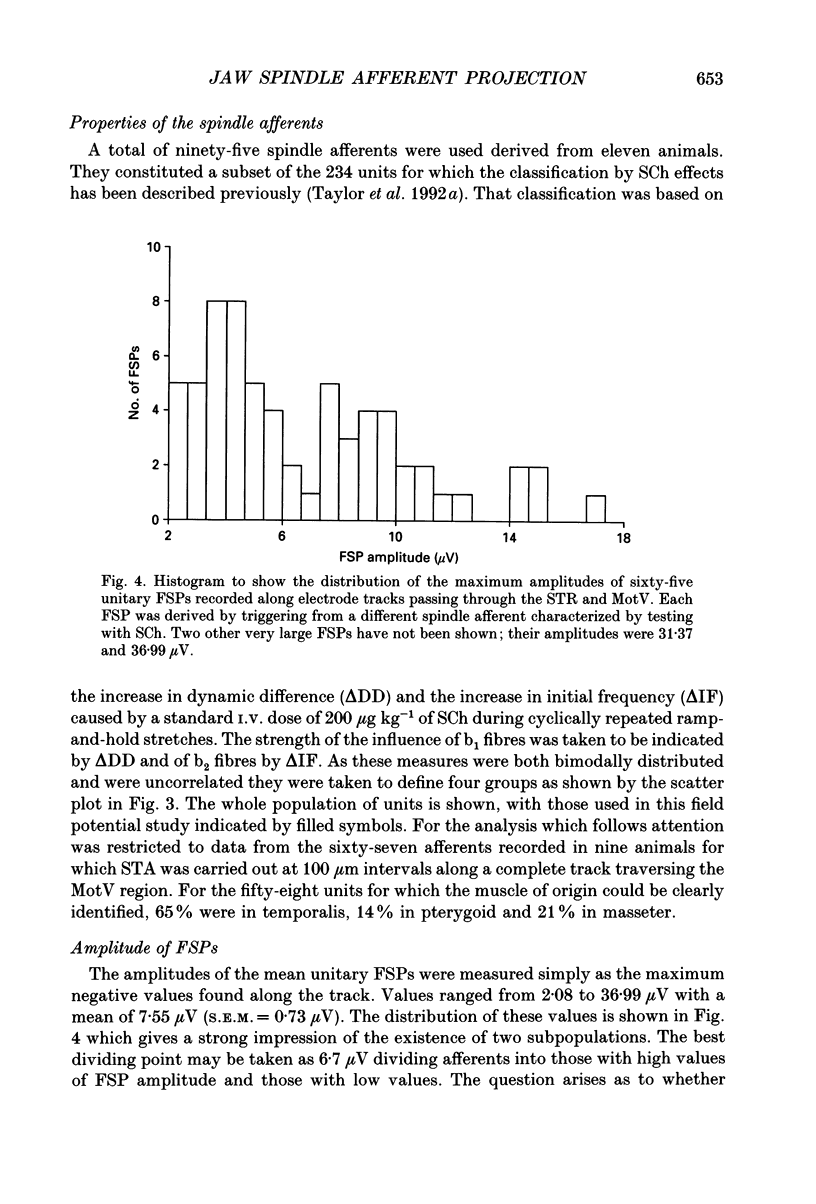

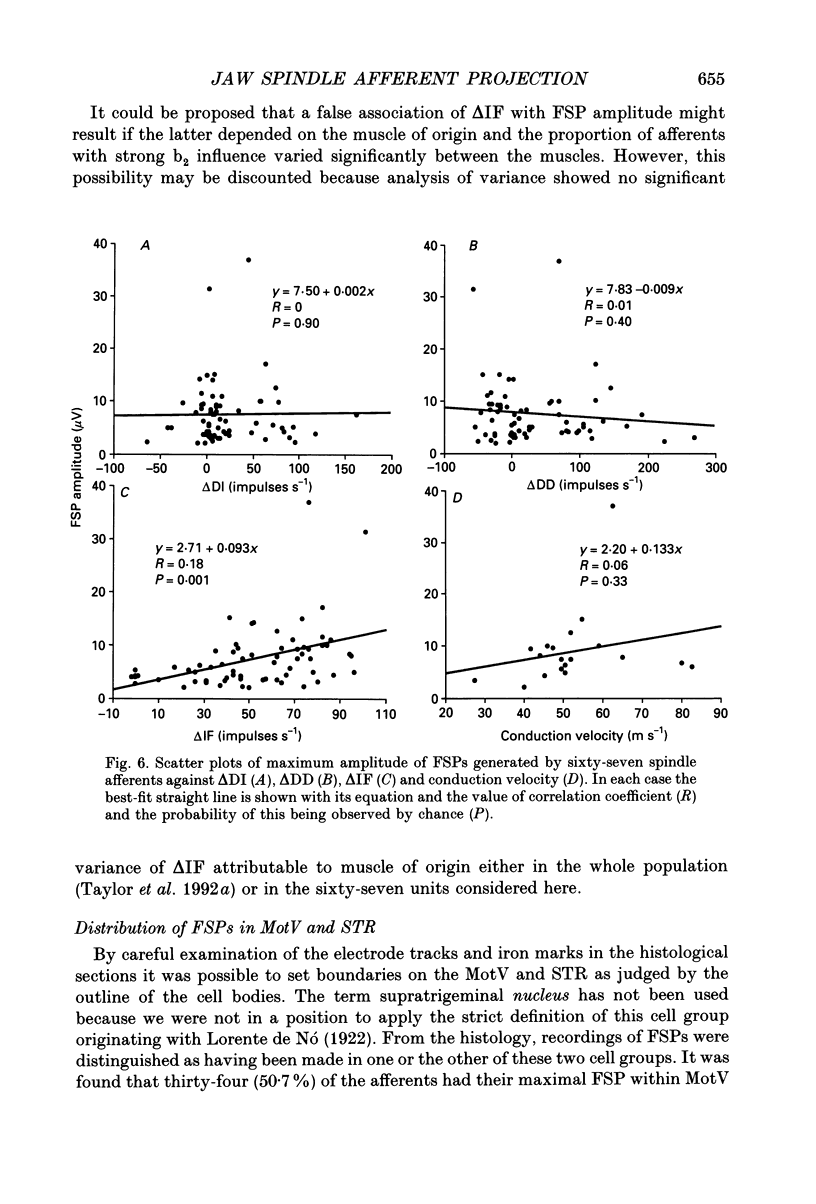
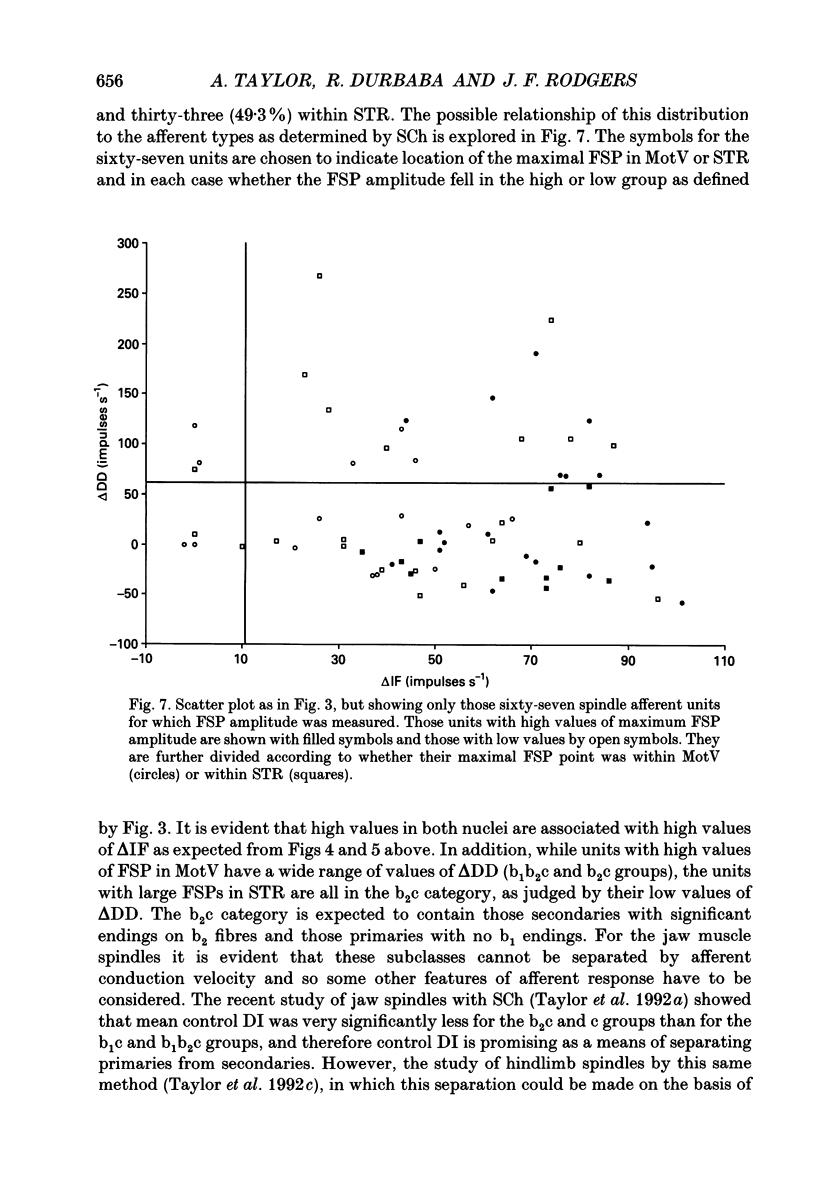
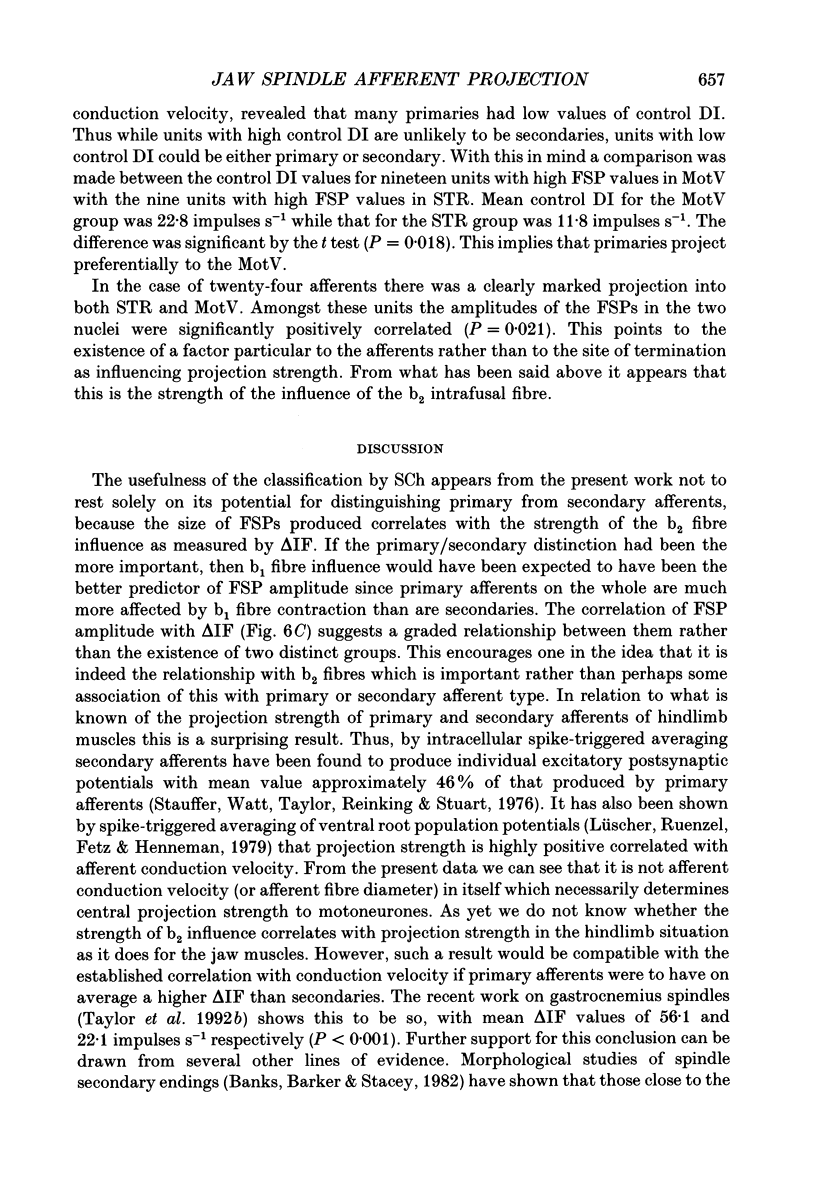
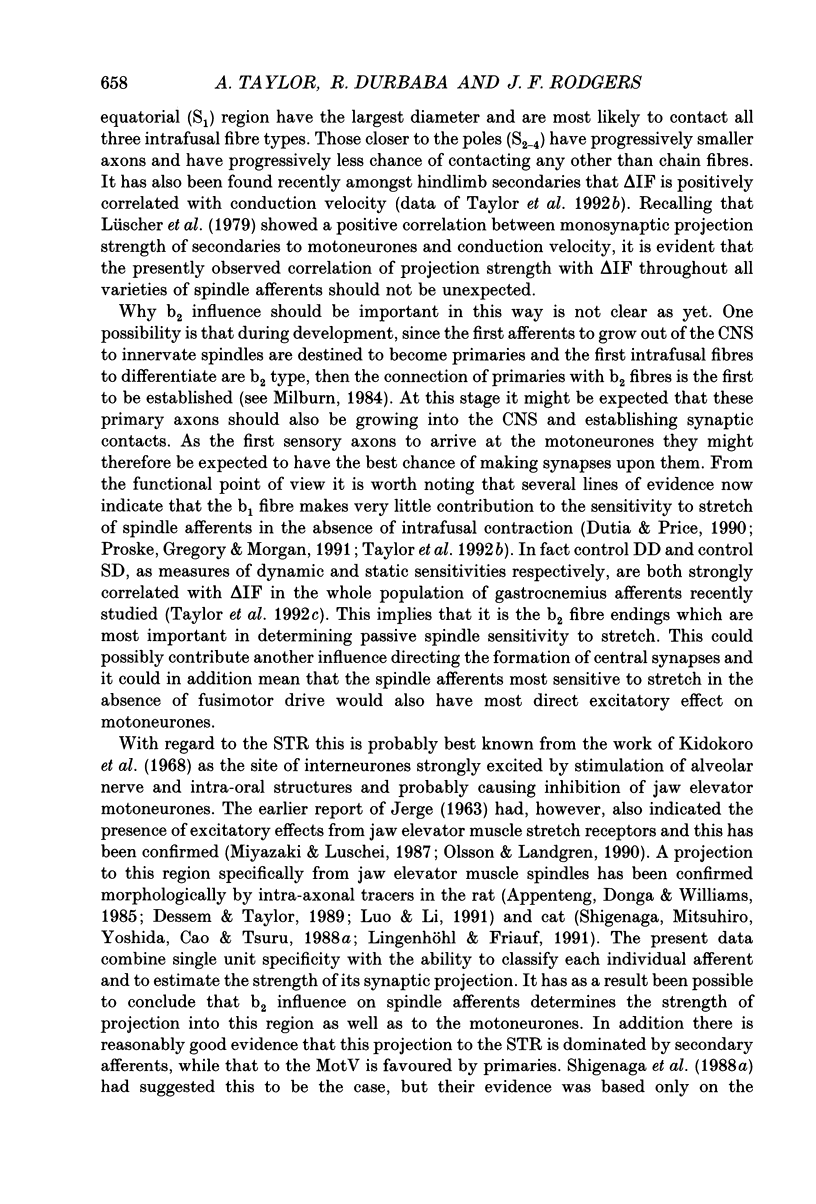
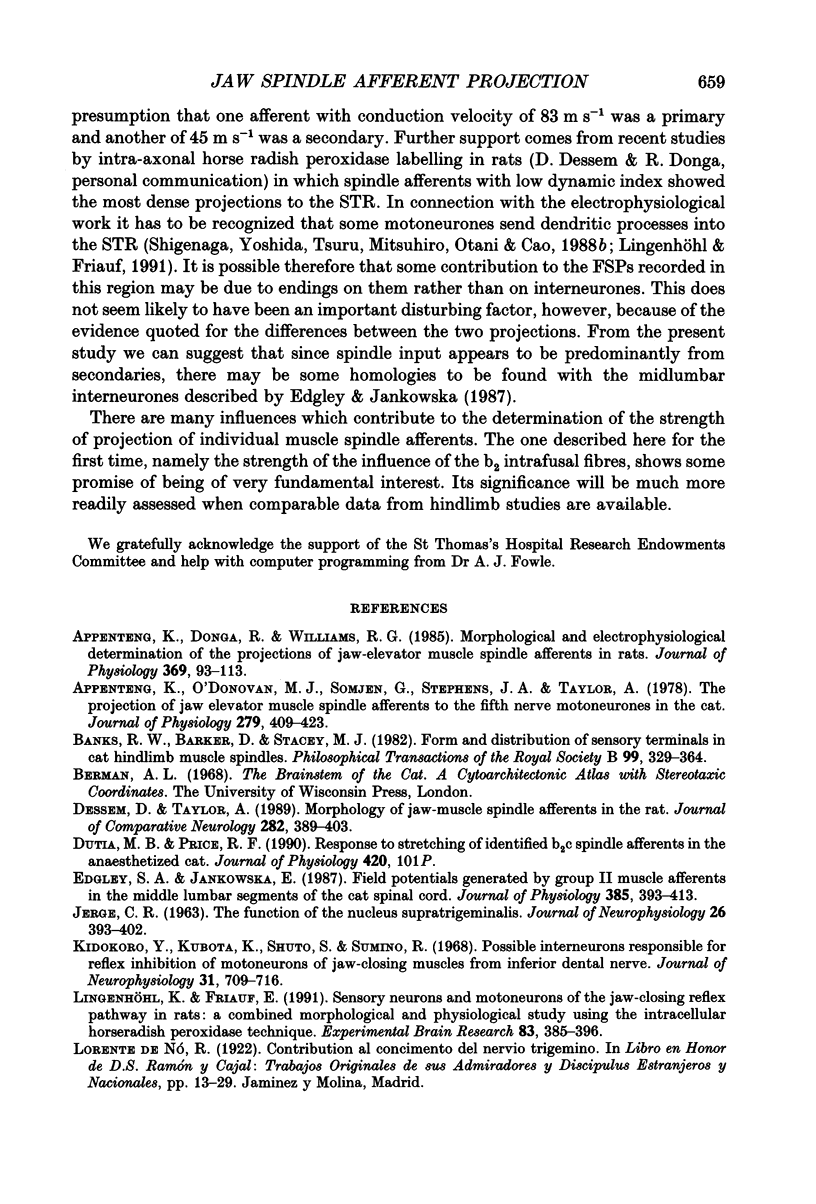

Images in this article
Selected References
These references are in PubMed. This may not be the complete list of references from this article.
- Appenteng K., Donga R., Williams R. G. Morphological and electrophysiological determination of the projections of jaw-elevator muscle spindle afferents in rats. J Physiol. 1985 Dec;369:93–113. doi: 10.1113/jphysiol.1985.sp015890. [DOI] [PMC free article] [PubMed] [Google Scholar]
- Appenteng K., O'Donovan M. J., Somjen G., Stephens J. A., Taylor A. The projection of jaw elevator muscle spindle afferents to fifth nerve motoneurones in the cat. J Physiol. 1978 Jun;279:409–423. doi: 10.1113/jphysiol.1978.sp012353. [DOI] [PMC free article] [PubMed] [Google Scholar]
- Banks R. W., Barker D., Stacey M. J. Form and distribution of sensory terminals in cat hindlimb muscle spindles. Philos Trans R Soc Lond B Biol Sci. 1982 Nov 4;299(1096):329–364. doi: 10.1098/rstb.1982.0136. [DOI] [PubMed] [Google Scholar]
- Dessem D., Taylor A. Morphology of jaw-muscle spindle afferents in the rat. J Comp Neurol. 1989 Apr 15;282(3):389–403. doi: 10.1002/cne.902820306. [DOI] [PubMed] [Google Scholar]
- Edgley S. A., Jankowska E. Field potentials generated by group II muscle afferents in the middle lumbar segments of the cat spinal cord. J Physiol. 1987 Apr;385:393–413. doi: 10.1113/jphysiol.1987.sp016498. [DOI] [PMC free article] [PubMed] [Google Scholar]
- Kidokoro Y., Kubota K., Shuto S., Sumino R. Possible interneurons responsible for reflex inhibition of motoneurons of jaw-closing muscles from the inferior dental nerve. J Neurophysiol. 1968 Sep;31(5):709–716. doi: 10.1152/jn.1968.31.5.709. [DOI] [PubMed] [Google Scholar]
- Luo P. F., Li J. S. Monosynaptic connections between neurons of trigeminal mesencephalic nucleus and jaw-closing motoneurons in the rat: an intracellular horseradish peroxidase labelling study. Brain Res. 1991 Sep 20;559(2):267–275. doi: 10.1016/0006-8993(91)90011-j. [DOI] [PubMed] [Google Scholar]
- Lüscher H. R., Ruenzel P., Fetz E., Henneman E. Postsynatpic population potentials recorded from ventral roots perfused with isotonic sucrose: connections of groups Ia and II spindle afferent fibers with large populations of motoneurons. J Neurophysiol. 1979 Jul;42(4):1146–1164. doi: 10.1152/jn.1979.42.4.1146. [DOI] [PubMed] [Google Scholar]
- Milburn A. Stages in the development of cat muscle spindles. J Embryol Exp Morphol. 1984 Aug;82:177–216. [PubMed] [Google Scholar]
- Miyazaki R., Luschei E. S. Responses of neurons in nucleus supratrigeminalis to sinusoidal jaw movements in the cat. Exp Neurol. 1987 Apr;96(1):145–157. doi: 10.1016/0014-4886(87)90176-2. [DOI] [PubMed] [Google Scholar]
- Munson J. B., Sypert G. W. Properties of single central Ia afferent fibres projecting to motoneurones. J Physiol. 1979 Nov;296:315–327. doi: 10.1113/jphysiol.1979.sp013007. [DOI] [PMC free article] [PubMed] [Google Scholar]
- Price R. F., Dutia M. B. Physiological properties of tandem muscle spindles in neck and hind-limb muscles. Prog Brain Res. 1989;80:47–7. doi: 10.1016/s0079-6123(08)62198-6. [DOI] [PubMed] [Google Scholar]
- Proske U., Gregory J. E., Morgan D. L. Where in the muscle spindle is the resting discharge generated? Exp Physiol. 1991 Sep;76(5):777–785. doi: 10.1113/expphysiol.1991.sp003543. [DOI] [PubMed] [Google Scholar]
- Ruffini A. On the Minute Anatomy of the Neuromuscular Spindles of the Cat, and on their Physiological Significance. J Physiol. 1898 Jul 26;23(3):190–208.3. doi: 10.1113/jphysiol.1898.sp000723. [DOI] [PMC free article] [PubMed] [Google Scholar]
- Shigenaga Y., Mitsuhiro Y., Yoshida A., Cao C. Q., Tsuru H. Morphology of single mesencephalic trigeminal neurons innervating masseter muscle of the cat. Brain Res. 1988 Apr 5;445(2):392–399. doi: 10.1016/0006-8993(88)91206-1. [DOI] [PubMed] [Google Scholar]
- Shigenaga Y., Yoshida A., Tsuru K., Mitsuhiro Y., Otani K., Cao C. Q. Physiological and morphological characteristics of cat masticatory motoneurons--intracellular injection of HRP. Brain Res. 1988 Oct 4;461(2):238–256. doi: 10.1016/0006-8993(88)90255-7. [DOI] [PubMed] [Google Scholar]
- Stauffer E. K., Watt D. G., Taylor A., Reinking R. M., Stuart D. G. Analysis of muscle receptor connections by spike-triggered averaging. 2. Spindle group II afferents. J Neurophysiol. 1976 Nov;39(6):1393–1402. doi: 10.1152/jn.1976.39.6.1393. [DOI] [PubMed] [Google Scholar]
- Taylor A., Durbaba R., Rodgers J. F. The classification of afferents from muscle spindles of the jaw-closing muscles of the cat. J Physiol. 1992 Oct;456:609–628. doi: 10.1113/jphysiol.1992.sp019356. [DOI] [PMC free article] [PubMed] [Google Scholar]
- Taylor A., Rodgers J. F., Fowle A. J., Durbaba R. The effect of succinylcholine on cat gastrocnemius muscle spindle afferents of different types. J Physiol. 1992 Oct;456:629–644. doi: 10.1113/jphysiol.1992.sp019357. [DOI] [PMC free article] [PubMed] [Google Scholar]
- Taylor A., Stephens J. A., Somjen G., Appenteng K., O'Donovan M. J. Extracellular spike triggered averaging for plotting synaptic projections. Brain Res. 1978 Jan 27;140(2):344–348. doi: 10.1016/0006-8993(78)90466-3. [DOI] [PubMed] [Google Scholar]
- Watt D. G., Stauffer E. K., Taylor A., Reinking R. M., Stuart D. G. Analysis of muscle receptor connections by spike-triggered averaging. 1. Spindle primary and tendon organ afferents. J Neurophysiol. 1976 Nov;39(6):1375–1392. doi: 10.1152/jn.1976.39.6.1375. [DOI] [PubMed] [Google Scholar]



